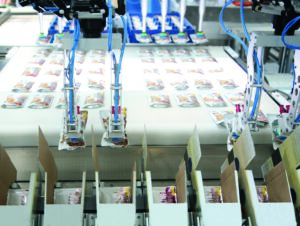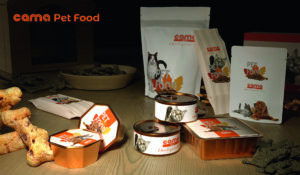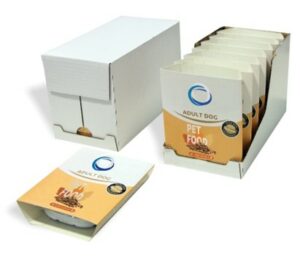Equipment Suppliers Solve Petfood Industry Challenges

Multiple food styles, portions and formulations require ultimate flexibility from secondary packaging machinery. Image courtesy of Cama North America.
Petfood Manufacturers Count on Flexibility, Sustainability and Easy-to-operate Machines
By Billy Goodman, Managing Director, Cama North America and Wim Kruikemeijer, Global Key Account Manager, Cama Group
We’ve witnessed a massive surge in demand for petfood and, as a result, our packaging technology. Petfood was already a significant market in 2019, and beginning in 2020 the pandemic drove pet ownership up even further. In fact, in 2021, the global pet food market size was valued at $110.53 billion. And the market is projected to grow from $115.50 billion in 2022, to $163.70 billion by 2029, exhibiting a compound annual growth rate of 5.11% during the forecast period.
Increasingly, petfood manufacturers are looking for flexibility, sustainability, and easy to operate machines. Whether they’re packaging dry pet food or wet, petfood manufacturers want the ability to run various product types, such as cans, cups, pouches, cartons, and bags.

The increasing number of package styles and portion-sized packages is being bolstered by research into sustainability, easy to open packaging and new shapes and designs to give inexpensive materials a premium appearance. Image courtesy of Cama North America.
Flexibility
The growing “humanization of pets” presents both challenges and opportunities for petfood manufacturers. High-quality pet food and packaging is now seen as a status symbol, which we have to design, fill, package and handle … very carefully. Not only does the primary packaging have to look good, but we also have to consider multi-flavor secondary packaging, which places extra pressures on packaging machines.
Multiple food styles, portions and formulations require ultimate flexibility from secondary packaging machinery. Petfood companies – both large and small – realize greater efficiencies when the automation of packaging operations absorbs the impact of changing market dynamics, including the natural progression of packaging. The right secondary packaging machinery manufacturer helps petfood companies keep up with trends in package formats such as cans, trays, pouches, cartons and cups. Finding a partner that can help meet the demand for multi-flavor packaging with integrated and highly flexible automation – often involving robotic pick-and-place systems – is also important.
Ease of operation
From a technology and machine perspective, extra capabilities, features and flexibilities addressing market demands are also driving up machine complexity. However, it is important to make more complex solutions easy to use because operators have the same skill sets.
Due to labor shortages and related changes, another request for equipment manufacturers is for easy to operate machines. Petfood packagers appreciate machines that offer accessibility, quick and easy changeovers, and that are simple to learn.
Technology such as Industry 4.0 is shaping the manufacturing landscape and optimizing internal and external processes by integrating technological know-how and new digital skills into classic production paradigms. Tools such as our Augmented Reality (AR) Machine Assistant and Virtual Reality generate value with improved machines and services by supporting operator training, troubleshooting, predictive maintenance, and spare parts management.

Cama’s Industry 4.0 program helps the customer to stay on top of predictive maintenance and have a better understanding of the machine through augmented reality (AR) instructions. Cama designs smart machines that are easily adaptable to environmental conditions and able to learn and suggest improvements to operators. Image Courtesy of Cama North America
Sustainability
Another challenge is to improve sustainability, from a materials standpoint and from a product standpoint. We can’t just look at sustainability in terms of materials or reducing plastic waste; we have to consider food waste too. Unfortunately, 25% of all food, including petfood, is wasted, and 75% of that waste is in the household, with the rest occurring during production.
It is responsible to investigate ways of helping consumers reduce waste, and to increase machine efficiency to drive down production waste. For example, quick changeovers mean lower dwell times, so there is less chance for the ingredients to spoil during production. However, solutions do require a balancing act. For instance, while portion-sized packages reduce consumer food waste, they can also increase the amount of materials used, and waste produced.

One way Cama is helping to address sustainability is the FW Wraparound Case Packer, which helps petfood packagers and other manufacturers save corrugate and reduce costs by packing their products in wrap-around or display ready cases, rather than a standard RSC. Image courtesy of Cama North America.
What does the future look like for petfood packaging equipment?
New-found levels of machine and process automation will drive creativity, because it will be easier to handle thanks to the agility and flexibility of modern control solutions.
Co-operation among customers and industry partners also presents a lot of opportunity to boost creativity in both processing and packaging. This is one reason Cama and ten other suppliers formed the Petfood Competency Network. The organization leverages knowledge and experience across the entire petfood value chain, and is expected to make massive strides into efficiency, machine-to-machine handover and interactions, as well as combined changeovers.
By looking at an entire line holistically, as opposed to a selection of suppliers, the efficiency opportunities for the end user are huge. The market is dynamic, and this collaborative approach is driving forward-thinking ideas and innovative solutions. This market is incredibly interesting, and we haven’t seen the half of what’s to come yet.
About the Authors
Billy Goodman is the Managing Director of Cama North America in Buffalo Grove, Illinois and Wim Kruikemeijer is the Global Key Account Manager with Cama Group, which is based in Lecco, Italy. Cama Group manufactures cartoning, case packing, sleeving, and robotic loading equipment, with decades of experience helping global clients in petfood and other industries develop turnkey packaging systems and sustainable solutions. To learn more, visit www.camagroup.com.







